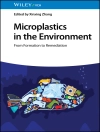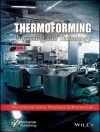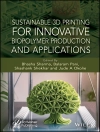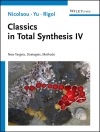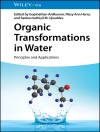In the only book to focus on new developments and innovations in this hot field international experts from industry and academia present everything scientists need to know.
The first section provides general concepts of the synthesis and properties of epoxy polymers and serves as a basis for the subsequent chapters. The second section includes new types of epoxy polymers recently commercialized or not yet present on the market, while the third section includes chapters related to the capacity of generating controlled nanostructures in epoxy-based materials. A fourth section is devoted to innovations in epoxy-based materials such as adhesives, coatings, pre-pregs, structural foams, injection-molded products and self-healing epoxies. Concluding remarks and perspectives are discussed in a short final section.
The result is a one-stop reference source, collecting scientific and technological breakthroughs otherwise spread over hundreds of publications, patents and reports.
Inhoudsopgave
Preface .
List of Contributors .
1 General Concepts about Epoxy Polymers (Jean-Pierre Pascault and Roberto J.J. Williams).
1.1 Polymerization Chemistry of Epoxy Monomers.
1.2 Transformations During the Formation of an Epoxy Network.
1.3 General Properties of Epoxy Networks.
References.
Part One New Polymers/Materials .
2 Thermoplastic Epoxy Polymers (Jerry E. White).
2.1 Introduction.
2.2 Synthesis and Characterization of Epoxy Thermoplastics.
2.3 Fundamental Properties of Epoxy Thermoplastics.
2.4 Conclusions.
Acknowledgments.
References.
3 Epoxy Functional Acrylic Polymers for High Performance Coating Applications (Carmen Flosbach and Roger Fugier).
3.1 Introduction.
3.2 Epoxy Functional Acrylic Polymers (Epoxy Acrylates).
3.3 Synthesis of Epoxy Acrylates.
3.4 Design of Epoxy Acrylates as Film-forming Components in Coatings.
3.5 Cross-linking Reactions in Coating Systems.
3.6 Conclusions.
References.
4 Epoxy Polymers Based on Renewable Resources (Alessandro Gandini).
4.1 Introduction.
4.2 Synthesis and Polymerization of Monomers and Macromonomers Bearing Multiple Epoxy Functions.
4.3 Synthesis and Polymerization of Monomers Bearing a Single Epoxy Group.
4.4 Conclusions.
References.
Part Two (Nano)Structured Epoxy Networks .
5 Nanostructured Epoxies by the Use of Block Copolymers (Sixun Zheng).
5.1 Introduction.
5.2 Formation Mechanisms of Nanostructures in Thermosets.
5.3 Morphologies of Epoxy Thermosets Modified With Block Copolymers.
5.4 Thermomechanical Properties of Nanostructured Thermosets.
5.5 Conclusions.
References.
6 Self-Assembly of Epoxy-Based Polymers (Cristina E. Hoppe and Roberto J.J. Williams).
6.1 Introduction.
6.2 Linear Nanostructured Epoxies.
6.3 Crosslinked Nanostructured Epoxies.
6.4 Possible Applications of Nanostructured Epoxies.
References.
7 Polymer Dispersed Liquid Crystal, Thermotropic and Other Responsive Epoxy Polymers (Agnieszka Tercjak and Inaki Mondragon).
7.1 Epoxy-Based Polymer Dispersed Liquid Crystal.
7.2 Polymer Dispersed Liquid Crystal Prepared by PIPS.
7.3 Block Copolymers Used as a Polymer Dispersing Agent for Liquid Crystal.
7.4 Epoxy Polymers Based on Azo-Benzene Organic Molecules.
7.5 Conclusions and Perspectives.
References.
8 POSS and Other Hybrid Epoxy Polymers (Libor Matějka).
8.1 Introduction.
8.2 Epoxy-Silica Hybrids.
8.3 Epoxy – POSS Hybrids.
8.4 Conclusions.
Acknowledgment.
References.
9 Lamellar Silicate-Modified Epoxies (Jannick Duchet-Rumeau and Henry Sautereau).
9.1 Introduction.
9.2 Structure and Properties of Lamellar (Phyllo) Silicates.
9.3 Morphologies of Lamellar Silicates-Polymer Nanocomposites.
9.4 Chemical Modification of Lamellar Silicates for Epoxy Networks.
9.5 Dispersion and Structuration of Lamellar Silicates in the Initial Formulation.
9.6 Structuration of Lamellar Silicates in a Reactive Medium.
9.7 Mechanical Properties of Lamellar Silicates-Modified Epoxies.
9.8 Ternary Blends Based on Epoxy/Layered Silicates.
9.9 Barrier Properties of Nanoclay-Modified Epoxies.
9.10 Conclusions.
References.
10 Epoxy/Carbon Nanotube Nanocomposites (Luyi Sun and Hung-Jue Sue).
10.1 Introduction.
10.2 Preparation of Epoxy/CNT Nanocomposites.
10.3 Properties of Epoxy/CNT Nanocomposites.
10.4 Summary and Outlook.
References.
Part Three Innovative Formulations and Processing .
11 Epoxy Adhesives: A View of the Present and the Future (Senen Paz Abuin).
11.1 Introduction.
11.2 Requirements and Conditions for the Design of an Epoxy Formulation.
11.3 Criteria for Selecting Adhesive Formulations.
11.4 Conclusions and Perspectives.
Acknowledgments.
References.
12 UV-Cured Nanostructured Epoxy Coatings (Marco Sangermano).
12.1 Introduction.
12.2 Organic–Organic Nanocomposite Epoxy Coatings.
12.3 Organic–Inorganic Nanocomposite Epoxy Coatings.
12.4 Conclusions.
Acknowledgments.
References.
13 Electron Beam Curing of Epoxy Composites (Felipe Wolff-Fabris and Volker Altstadt).
13.1 Introduction to Electron Beam Curing.
13.2 Material’s Features.
13.3 Manufacturing Process.
13.4 Perspectives.
References.
14 Composite Processing: State of the Art and Future Trends (Stephan Costantino and Urs Waldvogel).
14.1 Introduction.
14.2 Infusion.
14.3 Resin Transfer Molding.
14.4 Prepreg.
14.5 Alternative Mold Heating Methods.
14.6 Sheet Molding Compound (SMC)/Bulk Molding Compound (BMC).
14.7 Filament Winding.
14.8 Pultrusion.
14.9 Expandable Epoxy Systems.
14.10 Conclusions and Trends for the Future.
References.
15 Thermoplastic Curable Formulations (Thomas Fine, Raber Inoubli, Pierre Gerard, and Jean-Pierre Pascault).
15.1 Introduction.
15.2 Typical Preparation of Thermoplastic Curable Formulations.
15.3 Rheological Behavior of Blends of Block Copolymer and Thermoset Precursors.
15.4 Choice of the Hardener.
15.5 Processing and Properties.
15.6 Conclusions.
Acknowledgments.
References.
16 Structural Epoxy Foams (Lisa A. Mondy, Rekha R. Rao, Harry Moffat, Doug Adolf, and Mathew Celina).
16.1 Background.
16.2 Continuum-Level Model for Foaming Materials.
16.3 Material Models and Experiments to Populate Numerical Model.
16.4 Numerical Method.
16.5 Model Validation.
16.6 Discussion and Suggested Improvements to the Model.
16.7 New Foaming Strategies to Minimize Gravity-Induced Density Gradients.
16.8 Summary.
Acknowledgments.
References.
17 Self-Healing Epoxy Composites (Michael W. Keller).
17.1 Introduction.
17.2 Sequestered Healing-Agent Systems.
17.3 Intrinsically Healing Materials.
17.4 Potential Applications of Self-Healing Materials in a Bio-Engineering Setting.
17.5 Outlook for Self-Healing Materials.
References.
Part Four Conclusions and Perspectives .
18 Conclusions and Perspectives (Jean-Pierre Pascault and Roberto J.J. Williams).
18.1 Definitions of Epoxy Polymers.
18.2 New Monomers and Formulations.
18.3 Nanostructured Epoxies.
18.4 Engineering Properties.
18.5 Functional Properties.
18.6 Health-Related Issues.
18.7 Life-Cycle Assessment.
References.
Index .
Over de auteur
Professor Jean-Pierre Pascault is Emeritus from 2005 at National Institute of Applied Science (INSA) Lyon France. He was Professor in the same Institute from 1983 to October 2005; Director of the Laboratory of Macromolecular Materials (Associated to CNRS) from 1982 to 1998; Director of a CNRS Polymer Network Group (FR CNRS) from 2000 up to 2006; President of the French Polymer Group, GFP, and of the Polymer Division of the French Chemical Society, SFC from 2001 to 2004. He has authored over 300 scientific publications including several book chapters and one book and 32 patents.
Professor Roberto J. J. Williams is Head of the Polymer Division of the Institute of Materials Science and Technology (INTEMA), depending on the University of Mar del Plata and the National Research Council (CONICET), Argentina. He has authored over 200 scientific publications including several book chapters and two books (Thermosetting Polymers; Diffusion in Gases and Porous Media). His main contributions have been in the fields of thermosetting polymers and organic-inorganic hybrid materials. He has received several scientific awards and is a member of the National Academies of Engineering and Exact Sciences.



